Meta AI Chatbot (2024 Review): Is it Worth the Hype?
In an increasingly crowded field, Meta’s AI ChatBot is accessible via Meta’s popular messaging apps—including Messenger, WhatsApp, and Instagram DM—making it well-suited for quick searches.
The post Meta AI Chatbot (2024 Review): Is it Worth the Hype? appeared first on eWEEK.
Meta AI Chatbot Quick Facts
Our Rating: 3.4/5
Pricing: Free
Key Features:
- Integrates with popular Meta applications
- Internet access ensures it has the latest information
- Can generate up to 100 images, including animations
Meta is taking advantage of the popularity of its Facebook Messenger, Instagram Direct Message (DM), and WhatsApp platforms to provide access to its new Meta AI chatbot, letting users interact with the AI in private and group chats like a portable virtual assistant. It’s also available as a standalone tool from the Meta AI website. Built around open-source large language model (LLM) Llama 3 and optimized to provide a better, faster user experience, the chatbot has generated a lot of buzz. But is it worth all the hype?
The short answer is that it depends. It’s less accurate than some competitors—including ChatGPT, Claude, Google Gemini, and Microsoft Copilot, to name a few—and prone to hallucinations, but is likely to improve quickly as it learns from user data. It also lets you create more images than other tools, and lets you animate them. Meta AI is not perfect, but if it meets your use case needs, the free tool offers a low bar for entry into the world of AI chatbots.
Meta AI Chatbot Review: What You Need to Know
|
Continue reading to learn about Meta AI chatbot’s pricing, features, intelligence, integrations, and alternatives, or jump ahead to see how I scored it across six main categories.
TABLE OF CONTENTS
Who Should Use the Meta AI Chatbot?
The Meta AI chatbot functions as a versatile AI virtual assistant for students, businesses with a social media presence, and companies focused on customer service, among others. Here are some of the best-suited use cases:
- Businesses on Social Media Presence: Small and medium-sized businesses (SMBs) with a social media presence can benefit from the Meta AI chatbot, as it can handle online customer inquiries 24/7, post content, and reply to posts and comments to boost customer engagement.
- Students and Researchers: Students or researchers needing quick information retrieval can use the Meta AI chatbot to gather data, summarize resources, and act as a study aid to help clarify concepts, solve problems, and provide digestible summaries of complicated topics.
- Companies Focused on Customer Service: Because the Meta AI chatbot can provide 24/7 availability, businesses can deploy it to improve customer service response times and provide quick resolutions to common problems. It can also help manage high volumes of inquiries, especially during peak hours or seasons.
Who Shouldn’t Use the Meta AI Chatbot?
AI chatbots use data to improve their performance, which can raise privacy concerns for some people. In addition, there are a few situations in which the Meta AI chatbot might not be the best fit.
- Patients Seeking Medical Care: Medical conditions can be extremely complicated, requiring a thorough understanding of the patient’s history, symptoms, and context that no AI chatbot can deliver.
- Individuals Who Need Legal Counseling: Legal concerns are frequently nuanced and require a detailed understanding of the law; its precise application to individual circumstances is beyond AI’s capabilities.
- Users Concerned about Data Privacy: AI chatbots collect and keep user data to improve their services, raising questions about data security and privacy. Users risk having their personal information exploited, either by AI service providers or through possible data breaches.
Meta AI Chatbot: Pricing
Whether through Meta’s popular messaging apps or standalone on its website, the Meta AI Chatbot is free to use. If you’re using it standalone, you can use it as a private guest, but there are restrictions on what you can do. If you want to save your conversation history, generate image results, or sync the tool with your messaging app, you’ll need to log in using a Facebook or Instagram account.
One feature that distinguishes the Meta AI chatbot from its competitors is its free AI image generator. While its image generation capabilities are comparable to those of Microsoft Copilot, Meta AI allows users to generate up to 100 images per day, compared to just 15 with Copilot’s free plan.
5 Key Features of the Meta AI Chatbot
While the Meta AI chatbot stands out for its image creation, animation, and summarization skills, it can also suggest a trip itinerary, provide a starting point for academic research, or write blog content or email copy. Its accessibility through Meta’s products allows users to do quick research and generate images without changing applications.
Image and Video Creation
Meta AI lets users create AI-generated images using prompts. If you begin a prompt with the word “imagine,” the chatbot immediately suggests an image, even before you finish the prompt. Meta AI-generated images can be downloaded without compromising their quality. The images can be fairly realistic but are more likely to have a 3D or 4D effect, though in my testing they were very effective at displaying the intended concepts.
The image generation process is quick, depending on your internet speed, typically requiring only a few seconds to produce the initial images. If there are necessary changes, Meta AI responds well to suggestions by closely following the supplied image edit prompts.
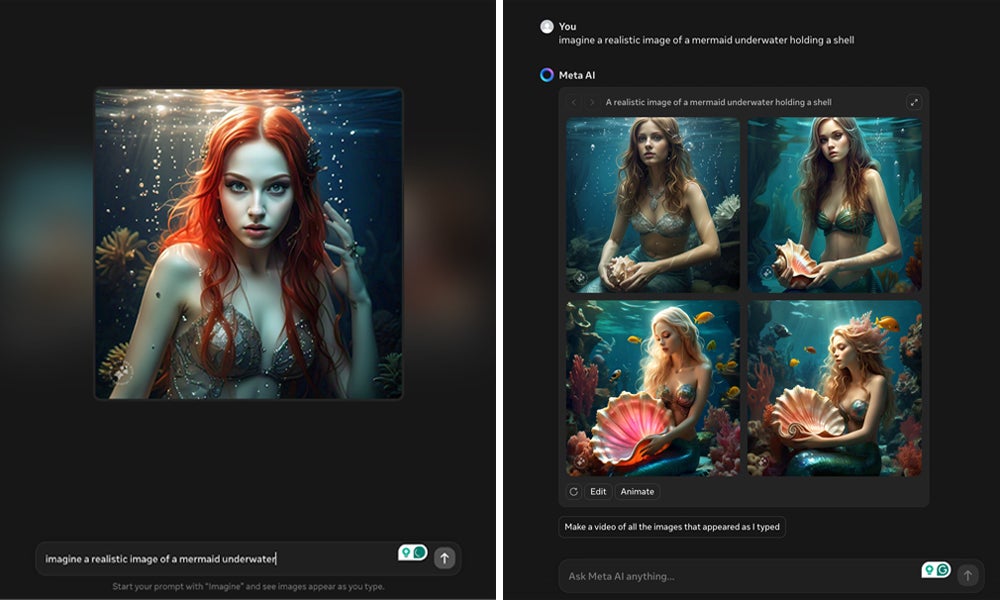
Once you’ve finished, the chatbot will generate four suggested images and give you the option of editing the image. To edit the chosen image, simply click the “Edit” button and give directions for the AI to refine the color or components, or add other features. The Meta AI chatbot also gives you the option to animate your chosen image into a 6 frames per second (FPS) animation.

Content Writing
Meta AI is a versatile tool that can create emails, blogs, articles, and social media post descriptions. User prompts have a significant impact on the output quality—to get the best outcomes, be clear and detailed in your prompts. Meta AI’s writing abilities are comparable to those of other advanced AI chatbots such as ChatGPT and Gemini (formerly Bard). You can select any of these tools based on your preferences and requirements.
When it comes to writing code for software development, WordPress plugins, or scripts, Meta AI falls short. Meta AI’s LLM is open-sourced, allowing other developers to edit and use it—in exchange, Meta is using this information to improve its coding ability. At this point, however, it’s not as good at coding as some competitors—for example, ChatGPT can deliver basic code for WordPress sites and can identify and fix bugs.
Trip Planning
The Meta AI chatbot can answer travel-related questions and help suggest trip itineraries, flights, and train schedules. But when it comes to being specific about the important details of the itinerary, you’ll need to be very detailed with your prompts—and even then, it can provide out-of-date information. I found creating itineraries to be difficult, with the Meta AI requiring numerous follow-up questions and providing only partial or inaccurate answers.
It relied on out-of-date sources to provide activity and event recommendations and gave incomplete responses. While Meta AI provided links for flights and hotels, it sometimes directed me to the wrong landing pages, making the procedure frustrating. Overall, Meta AI’s travel planning skills are behind compared to other AI chatbots.
Academic Research
The Meta AI chatbot has access to both Google and Bing search engines but still generates more general or outdated information with alarming frequency. While this can be a useful starting point for research, the tool is not yet a reliable source of information and should never be used without a lot of fact-checking.
While it’s not the most dependable tool for academic research, it can help choose precise terms and keywords to search on Google. Remember that this AI platform is still in its beta stage and is still learning a vast amount of data—in time, it might improve.
Summarization
When it comes to summarizing long-form articles, the Meta AI chatbot excels, picking up and detailing the important information to make it easier to fully understand a longer resource without having to read it all yourself. While this skill is pretty common with most AI chatbots, Meta stands out for its ability to summarize website articles straight from their URLs.

However, this ability is not yet reliably accurate. During my own testing, I asked Meta AI to summarize two different eWeek articles and got inconsistent results. For the first article, “What is Artificial Intelligence? Guide to AI,” it delivered the summary I was hoping for. But for the second, “How AI is Altering Software Development with AI-Augmentation,” it said it is unable to access external links and instead gave me some related information based on the keywords.
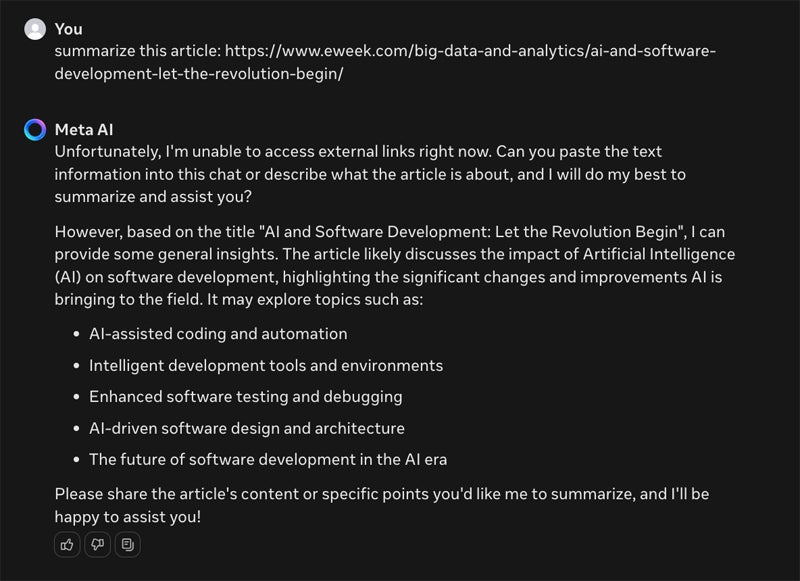
Meta AI Chatbot: Intelligence
The Meta AI chatbot’s knowledgebase—all of the knowledge and information uploaded to the tool by its creators—was current as of December 2023, which means the training data is already somewhat out of date. It also has real-time internet access through Bing and Google but relies on search engine results page data, which means it can sometimes provide inconsistencies or inaccuracies when it comes to giving current knowledge. While its ability to adapt and learn from new data sources helps it constantly improve, anyone relying on it for information that must be accurate should do their due diligence to double check.
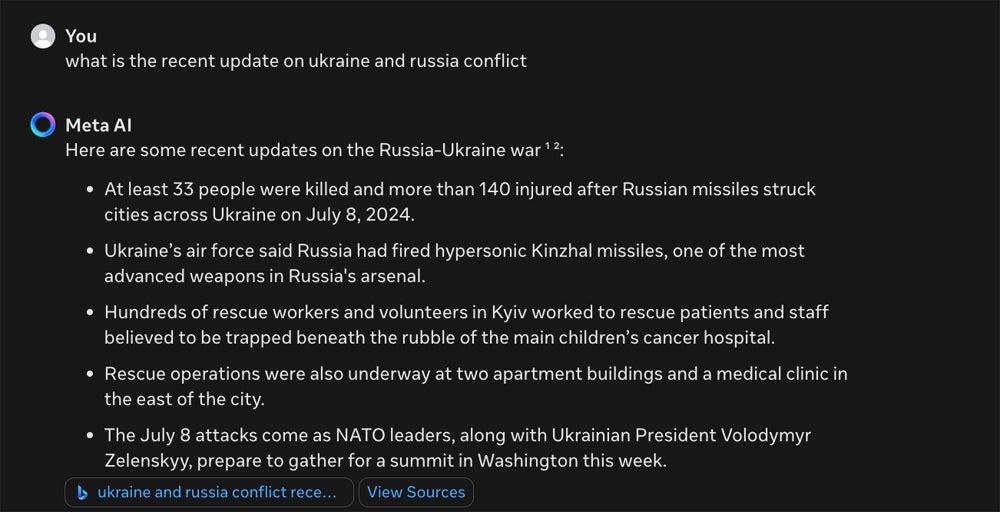
Meta AI Chatbot: Conversation Tone
Meta AI chatbot is programmed to adjust its conversation tone based on user input and the nature of the request. This improves user experience through personalized interactions by natural language processing (NLP). Its tonal range includes formal for professional situations, casual for general inquiries, and friendly for customer service, and first, second, and third person points of view.
The chatbot continuously analyzes conversational context to maintain an appropriate tone, and you can specify or change your preferences by adding a formal, casual, consultative, aggressive, passive, frozen, or intimate tone of voice to your prompts. It also provides compatibility with other complex chatbots, making it easier for users who are familiar with similar technologies. This adaptability meets a wide range of communication needs and preferences.
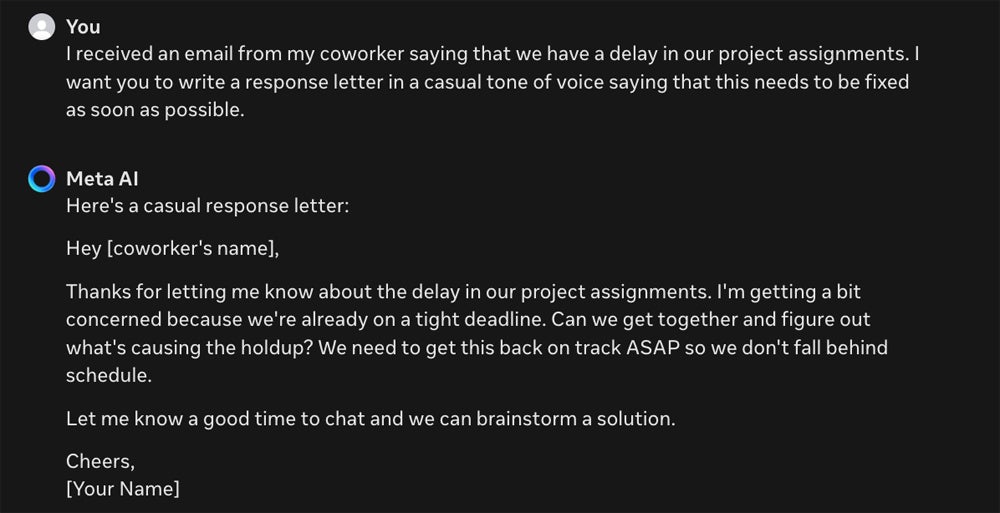
Above, Meta AI chatbot creates an email response in a casual tone of voice; below, the same email in a more formal tone.
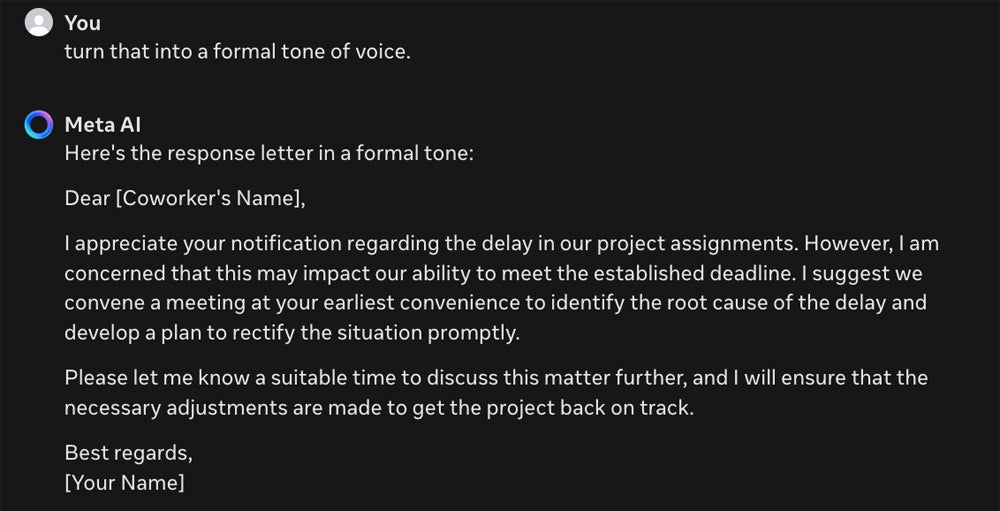
Meta AI Chatbot: Integration
Meta’s decision to integrate its AI chatbot across its messaging platforms allows a wide number of users to access the tool. It also gives the tool a huge amount of data to learn from. From any of those sites, you can access the chatbot by typing “@,” clicking “Meta AI,” and accepting the terms and conditions.
However, Meta AI does not integrate with Google Workspace or Microsoft Office. If you are looking for an AI chatbot that integrates with these productivity tools, you might prefer Microsoft Copilot or Google Gemini. These AI tools have already improved the productivity of their respective office suites by helping with writing, summarizing, and visualizing data.
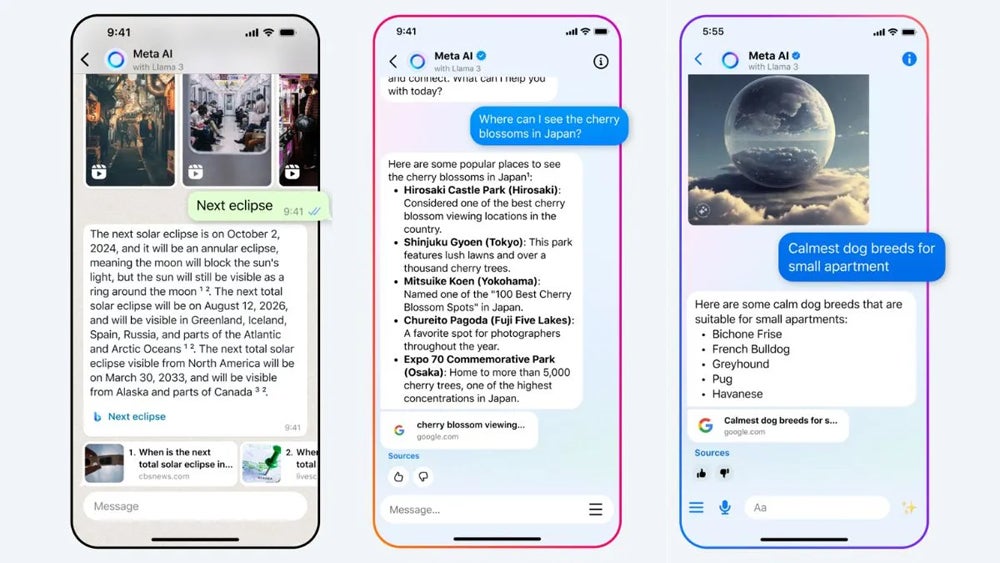
Alternatives to Meta AI Chatbot
The AI chatbot market is increasingly crowded since ChatGPT burst onto the scene a few years ago, and Meta AI has many competitors, each with its own strengths and weaknesses.
OpenAI ChatGPT
ChatGPT and Meta AI chatbots are intended for general-purpose conversational AI using powerful NLP techniques to interpret and generate human language while constantly learning from large datasets and user interactions. ChatGPT is known for its excellent language production skills and diversified training data, which contrasts with the Meta AI chatbot’s use of social media data to create engaging and realistic interactions. Access to ChatGPT’s AI image generator DALL-E and the tool’s more up-to-date knowledgebase costs $30 per month for a subscription.
Google Gemini
Like Meta, Google is a prominent tech company that uses its seemingly bottomless resources and expertise to provide advanced conversational abilities in its chatbot. Powered by Google DeepMind, Gemini has advanced problem-solving and reasoning abilities and focuses on advanced AI research. While there’s a free version, Gemini Advanced costs $19.99 per month.
Microsoft Copilot
Copilot and Meta AI have similar advanced NLP algorithms that help users interpret and write content, constantly improving through large training datasets and user interactions. Copilot is powered by OpenAI’s Codex, and the tool specializes in coding—including providing suggestions, completing snippets, and creating documentation within development environments. The paid version, Copilot Pro, costs $20 for individual users and $30 for businesses.
How I Evaluated the Meta AI Chatbot
In assessing the Meta AI chatbot, I identified six categories essential to chatbot platforms and divided each into weighted subcategories that total an overall score out of five to see how it performed.
Evaluation Criteria
I placed the highest weight on integrations, core features, and intelligence, followed by ease of use, conversation tone, and regulatory compliance.
- Integrations (25 percent): AI chatbots must be accessible to users, and for this category, I considered the tool’s integration with Meta’s popular messaging apps.
- Core Features (25 percent): Every AI chatbot should offer its ability to generate content that will meet its users’ needs for image generation, writing, basic research, summarization, and coding.
- Intelligence (20 percent): Chatbots should have both detailed knowledge from their training data and access to real time data, as well as the ability to learn and improve.
- Ease of Use (10 percent): A user-friendly and accessible AI chatbot allows users to easily communicate and search their queries in various forms.
- Conversation Tone (10 percent): To be useful in as wide a range of circumstances as possible, chatbots should be able to change their conversational tone.
- Regulatory Compliance (10 percent): Since AI learns from large datasets and user interaction, regulatory compliance is important to protect user data privacy and give users confidence that data they share is securely stored and used exclusively for large language modeling.
Bottom Line: Meta AI Chatbot is Best for Generic Inquiries and Social Interaction
Although the Meta AI chatbot entered the market later than its competitors, it is perhaps the most accessible AI chatbot available today. Its biggest benefit is its compatibility with Meta’s messaging apps and its ability to generate 100 AI images for free, which outperforms several of its competitors. While its output may contain inconsistencies from time to time, keep in mind that this AI model is still in its early stages and will only improve with time.
Read our prompt Engineering Guide to learn how to unlock the potential out of various AI chatbots.
The post Meta AI Chatbot (2024 Review): Is it Worth the Hype? appeared first on eWEEK.
